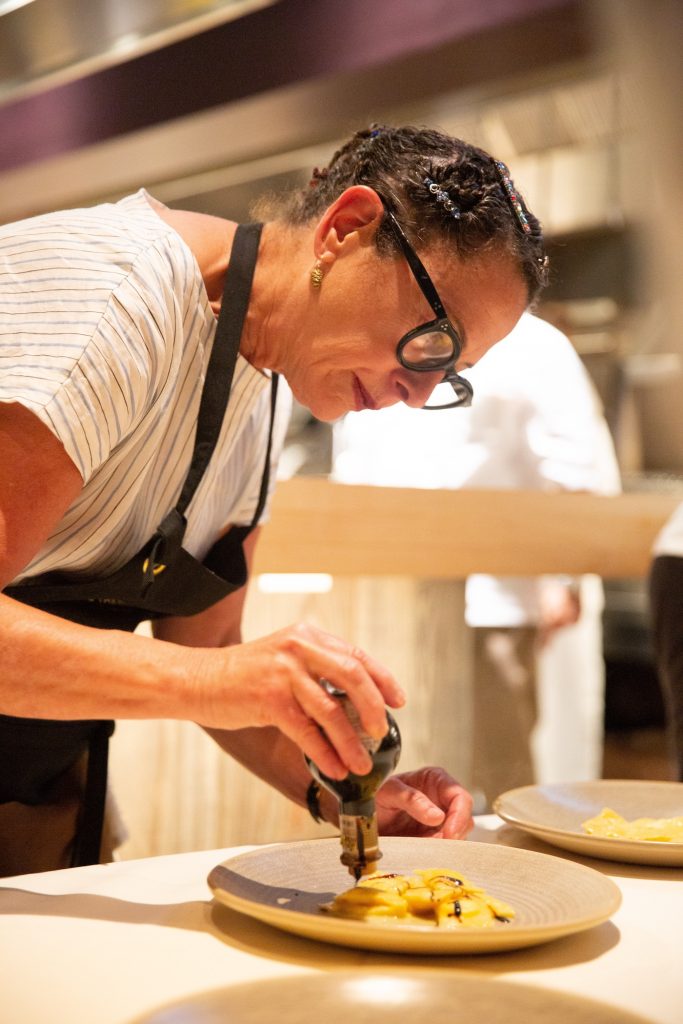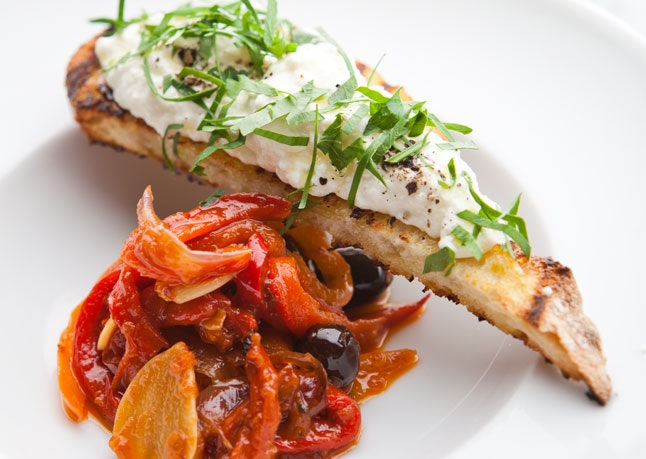In the Kitchen with Nancy Silverton
When Skepticism and Humor Become the Perfect Recipe for Artisanal Bread
Whenever I hear the name Le Cordon Bleu it reminds me of the time I took a “Savory Nibbles” cooking class at Le Cordon Bleu Paris with my mother-in-law, Marie. After completing the very first step of our course – to crack an egg and pour it into a bowl – my instructor, standing near my workspace, advised me in a very loud trill to remove the tiny fragment of eggshell that was floating in my bowl.

At break time, a few of my classmates giggled like schoolgirls at the lunch table when I told them in broken French that I was there to learn new recipes and “bond” with my mother-in-law. Marie, who lives in Washington, D.C., and is a terrific cook with a keen eye for recipes, was fully engaged in cordial discussions with the ladies sitting next to us about the intricacies of the day’s recipes.
My attempts to learn the art of French cooking continued at Le Cordon Bleu in Pasadena until the culinary school closed all 16 U.S. campuses in 2017.
Besides Julia Child, there is no other Le Cordon Bleu alum that I’ve admired as much as Nancy Silverton, the James Beard Award-winning pastry chef, cookbook author, and culinary ambassador at Ojai Valley Inn.
In the late ’80s Silverton’s pioneering La Brea Bakery produced artisan loaves that made everyone forget about San Francisco sourdough bread. Then she opened a string of wildly popular restaurants and wrote a whole slew of tantalizing cookbooks.
I wondered how she was surviving the pandemic. Like many Southern California restaurateurs, Silverton, who co-owns Pizzeria Mozza in Los Angeles and Newport Beach as well as Osteria Mozza, Mozza2Go, and chi SPACCA in Los Angeles, closed her dining rooms last spring. That was after she tested positive for COVID-19, and following the events that led to her downtown L.A. restaurants being ransacked and vandalized during early summer’s civil unrest.
But 2020 wasn’t all bad for Silverton. She wrote a cookbook, began her second-year residency in Ojai – the culinary events at Ojai Valley Inn are currently on hold – and recently celebrated the opening of a hip, new casual eatery called Pizzette at Citizen Public Market in Culver City.
For this late-December interview from her home in Los Angeles – which she fondly refers to as “San Quarantine” – she gave us her take on being a business owner and what her life has been like during the pandemic.
Q. As a business owner, what’s your take on the pandemic and its effect on the restaurant industry?
A. It has been devastating. There are so many clichés to say about the pandemic – “it’s like a bad movie,” “It’s hard to comprehend,” “It’s like living through a historically bad time,” and, sadly, they are all accurate.
You dropped out of Sonoma State University, where you were a political science major, and enrolled at Le Cordon Bleu in London. Did you feel you had a better chance at being a chef than as a politician?
I never ever intended to be a politician. Never. Isn’t poly-sci the go-to major people who don’t know what they want to study put down? When I expressed an interest in professionally becoming a cook, my father said, “If you are going to be a cook then I want you to go to the best cooking school.” Hence, Cordon Bleu.
With culinary schools like Le Cordon Bleu downsizing their programs, what advice do you have for budding chefs who want to join the service industry?
Join! And come see me about a job. But only join if it’s in your heart and soul. Join if you want to be a professional cook. Too many “budding chefs” as you call them, I think they see the TV shows on chefs and don’t realize the incredibly hard work it is as a “cook” before you become a “chef.” As for cooking schools, there are so many these days, many local that are fine. I was fortunate to have a father who sent me [to Le Cordon Bleu in the U.K.].
As a baker and pastry chef, you’ve had your share of disappointments in the kitchen while perfecting your recipes. What is the process like for you these days?
I try to make a dish as good as I can. And that involves, for example, a cook coming to me with an idea and having me taste a dish. It never, and I mean never, is ready to go as is. We tinker. We tinker. And we tinker. And it gets better. I’ll give you an example. This past week, Michael, the guy I live with [Michael Krikorian, former Los Angeles Times crime reporter] put the Christmas lights out on one [outdoor] tree, a pepper tree. And he put it on at night. But, I said, it’s not ready yet. “You need to make it better: more lights, higher lights.” The next day it got better. And the next. And finally, after the fifth day of him going up on the high steps of our ladder, it finally was good enough to “put on the menu,” or in this case to light up for the neighbors.
With Osteria Mozza, Pizzeria Mozza, and the newly opened Pizzette at Citizen Public Market in Culver City, how do you distinguish your concepts and ensure that each restaurant is unique?
The short answer is they all have distinct menus. You can’t get a pizza at Osteria or pasta at Pizzeria. Though when we were allowed to have outdoor seating at our “Piazza Mozza” — and hopefully will again soon – you could get both. As for Pizzette, we offer smaller pizzas and a completely different type of sandwich called the “stuffed pizzette.” The one thing they have in common is they are all delicious.
How do you balance being an artistic and innovative chef with being a businesswoman?
I have an undercover agent that makes that possible. Her name is Kate and she is my director of operations. You might never know if you came by because she’s been working the takeout line at Mozza 2Go!
In early 2019 you were named culinary ambassador of the new Farmhouse food and event space at Ojai Valley Inn. In what ways do you educate the public about sustainable foods?
I am as much a curator for the Farmhouse as I am an ambassador. While the Farmhouse is primarily about bringing the world’s best chefs to The Ojai Valley Inn for a grand time and delicious food, we always do touch on the important issue of sustainability when we talk about our ingredients. Our goal is to educate our guests the best way we know how, which is to serve them delicious, sustainable food.
What are you cooking at home these days? Has the pandemic inspired any new recipes?
During the beginning of the pandemic, Michael and I were cooking every day at home; grilling lamb shoulder and chops, ribeyes, and various fish. But for the last few months we have mainly just been getting food from Mozza. As for new recipes? Always. Pandemic or – and hopefully soon – no pandemic.
Nancy Silverton’s Peperonata With Ricotta Crostini

As published in Bon Appétit magazine
8 Servings
Ingredients
Peperonata
½ cup extra-virgin olive oil
1 large red onion, halved, cut into 1/4”-thick slices (about 2 1/2 cups)
¼ cup thinly sliced garlic cloves
2 teaspoons kosher salt, divided, plus more for seasoning
Freshly ground black pepper
2 red bell peppers, seeded, cut into 1/4”-thick slices
2 yellow bell peppers, seeded, cut into 1/4”-thick slices
2 orange bell peppers, seeded, cut into 1/4”-thick slices
1 tablespoon Sherry vinegar
1 tablespoon dried oregano
2 teaspoons sugar
1 cup Basic Tomato Sauce (recipe also found on Bon Appétit’s website)
½ cup pitted Arbequina or Niçoise olives
Assembly Ingredients
3 tablespoons thinly sliced flat-leaf parsley leaves, divided
2 cups D.I.Y. ‘Ricotta’ or store bought
4 Crostoni Bagnati, halved diagonally
High-quality extra-virgin olive oil
Maldon sea salt or fleur de sel
Freshly ground black pepper
Preparation
Step 1: Position a rack in middle of oven; preheat to 375°. Heat oil in a large skillet over medium heat. Add onion, garlic, 1 teaspoon salt, and a pinch of pepper; cook, stirring occasionally, until onion and garlic are translucent but not browned, 7-8 minutes. Add peppers and remaining 1 teaspoon salt; cook, stirring occasionally, until peppers begin to soften, about 5 minutes. Add vinegar, oregano, and sugar; stir for 1 minute. Add tomato sauce; stir for 2 minutes. Season peperonata with salt and pepper.
Step 2: Spread peperonata in an even layer in a 13x9x2” baking dish. Bake for 10 minutes. Remove from oven; stir in olives. Return to oven; bake until top is browned in spots and peppers are nicely roasted, about 45 minutes. Let cool at least 10 minutes.
Step 3: Divide peperonata among shallow bowls; sprinkle with 2 tablespoons parsley. Mound ricotta on top of Crostoni Bagnati. Drizzle with high-quality olive oil and top with a pinch of sea salt, pepper, and 1 tablespoon parsley. Rest 1 toast on each bowl.





